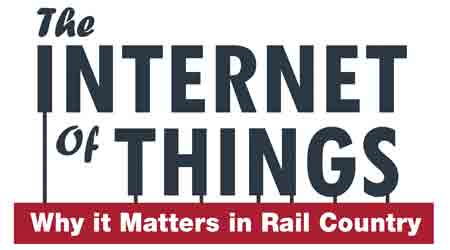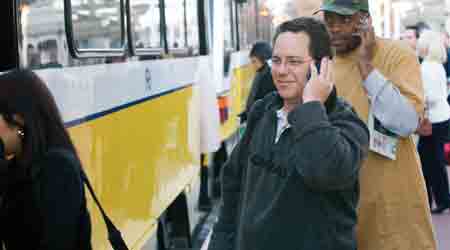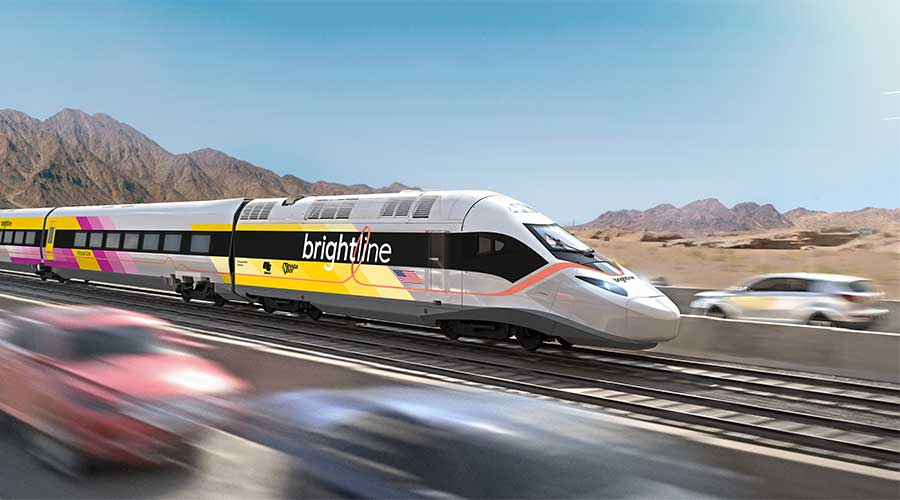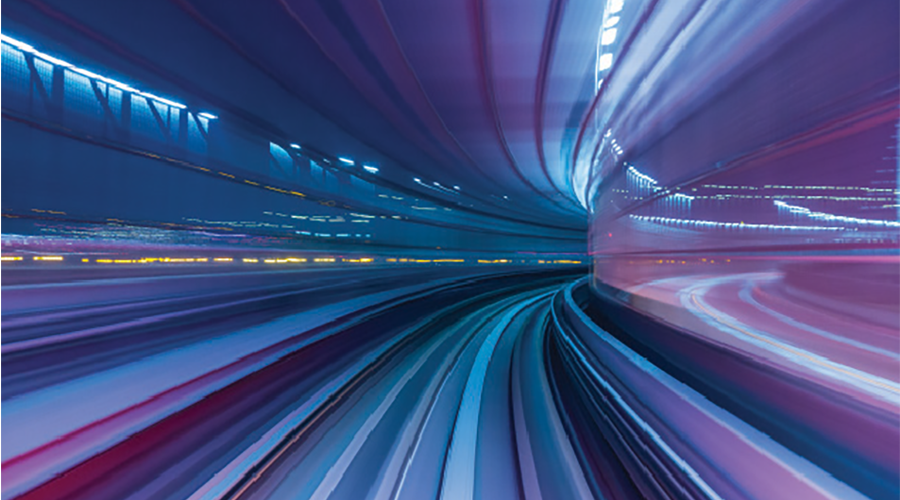Stay updated on news, articles and information for the rail industry
March 2016
Rail News: Passenger Rail
Internet of Things: Public transportation agencies are using Big Data to improve operational efficiency, safety and customer convenience

— by Julie Sneider, senior associate editor
Passenger railroads and transit agencies have been employing Internet of Things (IoT) principles to address a wide range of situations and challenges, from increasing operational efficiency, to enhancing safety and security, to addressing their state-of-good-repair backlog, to improving the experience of passengers riding the rails. And the data and analytics derived from IoT are increasingly being used to drive railroad executives’ decision-making, transit industry officials say.
For example, Dallas Area Rapid Transit (DART) is using data collected via IoT to improve its route planning by detecting traffic flow and congestion problems on its light-rail and bus lines; the Metropolitan Atlanta Rapid Transit Authority (MARTA) recently adopted the use of a portable ride performance assessment system to improve passenger comfort on MARTA trains; and Amtrak is using train communications data locomotive digital video recorder (TCD/LDVR) systems to transform how it manages train operations in the Northeast Corridor.
Dallas Area Rapid Transit
Dallas Area Rapid Transit (DART) riders can use the agency's Go Pass mobile app for iPhones and Androids to pay fares and plan trips. DART has been using data generated by the apps to market transit services in support of city events and conventions.
"We've been noticing the Internet of Things taking hold in the transit industry more and more," says Michael Wilson, managing director of North American public transportation at Accenture, a global information technology firm that counts transit agencies among its clientele. Wilson sees agencies applying IoT principles to address two primary areas: maintenance issues and state-of-good-repair backlogs, and mobile ticketing and fare collection.
On maintenance issues, Accenture has been working with a major North American transit agency to improve its asset management strategy by speeding up how it processes its repair backlog. To help maintenance teams tackle projects more quickly, the agency provided workers with tablets that can access sensor data electronically and in real time as they inspect track, vehicles and equipment in need of repair, says Wilson.
The tablets replaced the old-fashioned way of sending teams armed with clipboards into the field to record their observations on paper and then submit work-order forms once they get back to the office. Besides being more efficient, the new system has improved the accuracy of the information recorded and reported by the workers. The process is now being rolled out across the transit agency’s entire network, Wilson says.
A more efficient way to pay, collect
On the payment side of transit-rail operations, Wilson cited Union Pearson Express in Toronto as example of an agency’s application of IoT to improve fare collections. Fare enforcement officers on the higher-speed rail service, which runs between Toronto Union Station and Pearson International Airport, now use smartphones as their standard device to validate passengers’ fares in real time on the train, which helps decrease collection costs while increasing fare revenue, Wilson says.
And in Washington, D.C., Accenture has been working with the Washington Metropolitan Area Transit Authority (WMATA) on a pilot project to replace existing fare collection systems at 10 Metrorail stations, 50 Metrobuses and in two WMATA parking lots. The authority expanded fare payment options to include contactless bank cards, federal government identification cards and smartphones using near field communications (NFC), a short-range wireless connection that uses magnetic field induction to enable communication when two portable devices touch or are brought within a couple of inches of each other.
WMATA's new electronic payment system offers a number of advantages: It expands the options passengers can use to pay for transit rides; and it helps WMATA keep up with and offer the latest payment options — such as Apple Pay or Google Wallet. It also gives WMATA more flexibility in managing passengers’ accounts, analyzing their purchasing patterns and then targeting services to meet their interests and needs, Wilson says.
Also applying Big Data to revenue collection is the Los Angeles County Metropolitan Transportation Authority (Metro), which last month announced it's testing new video analytics software, video surveillance cameras and mobile phone validators as part of its fare enforcement strategy. The analytics software monitors activity at stations recorded by existing video surveillance cameras, highlights behavior that is out of the norm and alerts security personnel if a rider attempts to avoid paying a fare.
"The video analytics software is currently in its 'training phase' during which it monitors thousands of riders tapping their [Transit Access Pass] cards and entering the system," Metro Chief Executive Officer Phillip Washington said in a press release announcing the program. "If the software detects something out of the ordinary, such as a person jumping over the turnstile or using the ADA access gate without tapping, the system highlights it with a red box and sends video alerts to security personnel at that station who can conduct fare checks."
Metro also is upgrading handheld mobile phone validators (MPV) with law enforcement-specific, GPS-enabled software. The MPVs can detect if a card has been used to pay for a fare and the location where the MPV is being used. The upgrades will help L.A. County Sheriff’s Department deputies — who police Metro’s system — improve how they detect fare evaders.
"On the Metro system, conditions change constantly and law enforcement needs tools to assess needs and redeploy resources accordingly," said Ronene Anda, chief of the L.A. County Sheriff’s Department Transportation Policing Division. "As wireless Internet is rolled out on the subway system, the MPV upgrades will help our deputies get to where they are needed as never before."
From data to solutions
Whether it's through mobile ticketing or the electronic monitoring of operations, the transit industry generates a tremendous amount of data. Agencies now are in various stages of determining when, where and how to use all that information, says DART Vice President and Chief Information Officer Nicole Fontayne-Bardowell.
"The challenge is harnessing the data in an appropriate manner to improve overall operations," she says.
One way DART is using data to improve service is with its Traffic Signal Priority (TSP) system to coordinate the running of DART trains on city streets with motor vehicle traffic lights. By implementing a TSP system that features train detection and communications components, DART can reduce train travel time and conflicts with motor vehicle traffic.
"If there is a traffic jam in downtown Dallas, for example, the system will read that information and hold the trains at a particular station until the traffic moves along," explains Fontayne-Bardowell.
Additionally, DART uses information generated by automatic passenger counter equipment installed on its light-rail trains, which transmits passenger load data in real time to the train control center. The data is used to assess where passengers are getting on and off trains and where overcrowding exists "so that we can plan our routes and our coverage on those routes," she says.
Customer convenience, comfort
For DART passengers, the agency's "Go Pass" mobile app for iPhones and Androids can be used for paying fares and for planning trips to special events. DART has been using data generated by the apps to market transit services in support of conventions and other major events held in Dallas and Fort Worth. Case in point: When Dallas hosted the NCAA Final Four tournament in 2014, DART's Go Pass app bundled transit fare purchases with admission to the NCAA events.
"One other piece we’re looking at for the mobile ticketing pass is the use of sensors to validate fares," says Fontayne-Bardowell. "In the future, when people have their Go Pass app open on their phone, sensors installed on the train platforms would validate the app as a valid pass. That would take [mobile ticketing] a step beyond walking up to a validator and scanning it like you would do today at an airport. But that’s still a few years out."
Improving passenger comfort and safety was behind MARTA's recent decision to install dFuzion Inc.'s rMetrix ultraportable ride performance assessment system to monitor ride quality on the agency's commuter-rail lines. The sensor-based technology is designed to monitor, measure and report acceleration data in real time.
"The acceleration data can tell you whether or not the ride is smooth for the passengers' comfort," says dFuzion President Treasa Parakkat. "From the hidden data behind the accelerometer, you can figure out if there is a problem with the tracks or with the vehicle."
The rMetrix system geo-synchronizes the data to determine where an irregularity in the ride is occurring, then transmits the data to an Internet cloud where the information is analyzed. MARTA inspectors will use the analysis to diagnose problems on the track and/or vehicle, and recommend maintenance solutions.
"Sometimes transit agencies have problems with passenger comfort, where passengers report feeling nauseous because of the way the train is moving but they can’t pinpoint it," Parakkat says. "So, systems like this can help transit agencies pinpoint where [on the route] the problem is occurring. They also help determine if the problems are increasing or decreasing based on the agencies' maintenance activity."
Data collected from ride-quality monitoring also can be used to head off potential safety problems. To that end, Amtrak uses hot-box detectors and wheel impact load detectors that monitor wheel temperature to identify overheating situations that could lead to service disruptions. The data collected is used to determine when maintenance is required, says, Amtrak's senior vice president of business relations in information technology.
"Amtrak, like other railroads, is realizing the value of the Internet of Things and digital and analytics capabilities, and how those capabilities can drive efficiencies in our operations," says Ijam. "We do have current capabilities in the environment that would be considered IoT, but we will continue to invest in capabilities in the future that will connect the information we get from the IoT to the analytics that will help drive real-time decision-making."
From safety to fuel optimization
Another example of Amtrak applying IoT principles is its use of communications data derived from locomotive digital video recorders installed on trains operating in the Northeast Corridor.
Data gathered by the TCD/LDVR system not only reports safety-related events that occur on a train, it also can be used as a fuel-monitoring and fuel-cost optimizer that sends alerts on low-fuel conditions. The geo-fencing and satellite communication positioning technology in the system can communicate where the low-cost and high-cost refueling stops are located on the train's route, Ijam says.
"That information gets fed into operations to determine when is the right time to refuel the train," which helps Amtrak better manage fuel costs, she adds.
Amtrak's Ijam and Accenture’s Wilson say the future of IoT in passenger rail lies in railroad execs using data analytics to make better business decisions.
"As systems become more interconnected to [data-collecting] sensors, activities and devices, there will be greater accuracy of data," says Wilson. "You will begin to see a lot more of the analytics being used to power decisions such as how to manage congestion in cities, how to predictively tackle maintenance, and even how to maintain existing and attract new customers."
Wilson notes some transit agencies are starting to follow the retail industry’s lead by using Big Data to build customer loyalty to their brand. An example is Toronto's GO Transit, which offers a customer-loyalty fare discount program as part of a new fare management system.
"What we're seeing with this revolution is that the Internet of Things is really giving transit agencies more tools to go after issues such as maintaining a state of good repair, improving fare collection, attracting better customers and even empowering workers to do their jobs more efficiently," Wilson says. "And now the analytics are starting to kick in, which will produce more value for agencies in the future."
Email comments or questions to julie.sneider@tradepress.com.
Keywords
Browse articles on Dallas Area Rapid Transit Nicole Fontayne-Bardowell transit agencies passenger railroads Internet of Things Big Data Metropolitan Atlanta Rapid Transit Authority Amtrak Ghada Ijam dFuzion Inc. rMetrix Treasa Parakkat Accenture Michael WilsonContact Progressive Railroading editorial staff.


 2025 MOW Spending Report: Passenger-rail programs
2025 MOW Spending Report: Passenger-rail programs
 Gardner steps down as Amtrak CEO
Gardner steps down as Amtrak CEO
 Guest comment: Oliver Wyman’s David Hunt
Guest comment: Oliver Wyman’s David Hunt
 Women of Influence in Rail eBook
Women of Influence in Rail eBook
 railPrime
railPrime







